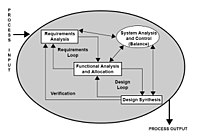
Photo from wikipedia
We are living in an age of growing demand for software products. This growing demand creates opportunities for very small entities (VSEs) to not only survive but also flourish. In… Click to show full abstract
We are living in an age of growing demand for software products. This growing demand creates opportunities for very small entities (VSEs) to not only survive but also flourish. In this context, VSEs need to produce high‐quality products to meet market needs. However, in their quest to produce high‐quality software, VSEs need to overcome the challenge of implementing international standards, which they find difficult to do because of lack of knowledge and practical experience. This paper provides an analysis performed to 13 teams of VSEs, using different life cycles, which achieved the implementation of the ISO/IEC 29110, to analyze the effort each team invests to implement the best practices provided by the standard. Besides, the paper provides an analysis of the difficulties, and the benefits of using the six‐step method are included. This analysis is of interest because software engineering knowledge developed by researchers should be transferred to the industry to reduce the gap between them. The results highlight, on the one hand, the practices representing more effort for teams by life cycle. On the other hand, the results highlight the six‐step method that allowed the 13 teams to achieve a high level of coverage of the ISO/IEC 29110 international standard.
Journal Title: Journal of Software: Evolution and Process
Year Published: 2020
Link to full text (if available)
Share on Social Media: Sign Up to like & get
recommendations!